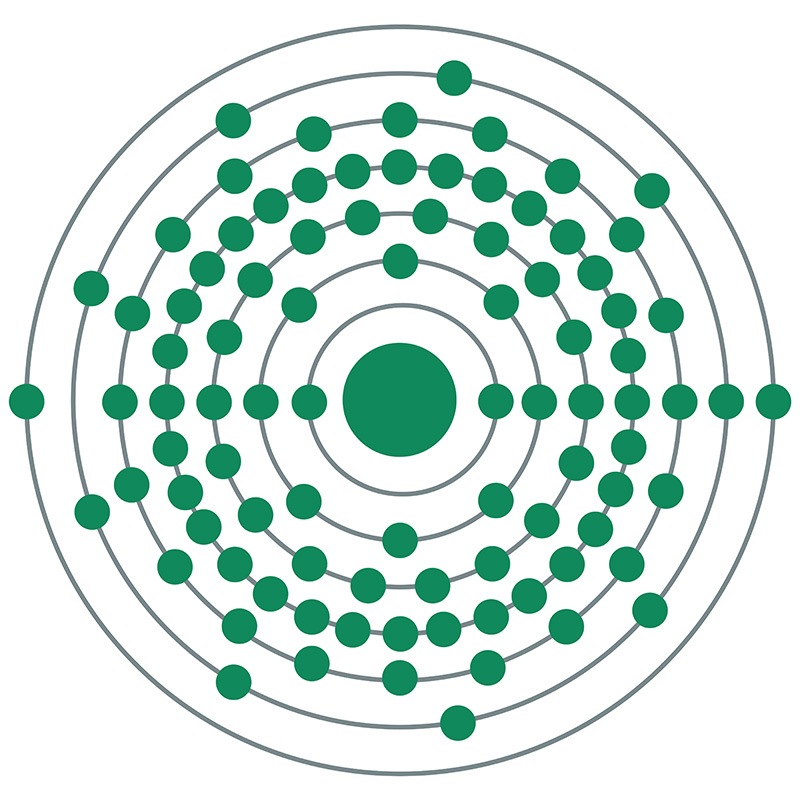Math Is Fun Forum
You are not logged in.
- Topics: Active | Unanswered
Pages: 1
#1 2025-09-24 16:08:45
- Jai Ganesh
- Administrator

- Registered: 2005-06-28
- Posts: 52,105
Protactinium
Protactinium
Gist
Protactinium (Pa) is a radioactive actinide metal with atomic number 91, known for its high radioactivity, toxicity, and scarcity, limiting its use to scientific research. A rare, dense, silvery-gray element, protactinium is found in trace amounts in uranium ores and is also produced from nuclear fuel reprocessing. It has no commercial applications and requires careful handling.
Protactinium has no major commercial uses due to its high radioactivity, toxicity, and extreme scarcity, but it is used in scientific research as a tracer element in nuclear physics, to study radioactive decay processes, and in radiometric dating of ocean sediments to reconstruct past climate events. Its most stable isotope, protactinium-231, is particularly useful for dating sediments up to 175,000 years old by measuring its 231Pa/230Th ratio.
Summary
Protactinium is a chemical element; it has symbol Pa and atomic number 91. It is a dense, radioactive, silvery-gray actinide metal which readily reacts with oxygen, water vapor, and inorganic acids. It forms various chemical compounds, in which protactinium is usually present in the oxidation state +5, but it can also assume +4 and even +3 or +2 states. Concentrations of protactinium in the Earth's crust are typically a few parts per trillion, but may reach up to a few parts per million in some uraninite ore deposits. Because of its scarcity, high radioactivity, and high toxicity, there are currently no uses for protactinium outside scientific research, and for this purpose, protactinium is mostly extracted from spent nuclear fuel.
The element was first identified in 1913 by Kazimierz Fajans and Oswald Helmuth Göhring and named "brevium" because of the short half-life of the specific isotope studied, 234mPa. A more stable isotope of protactinium, 231Pa, was discovered in 1917/18 by Lise Meitner in collaboration with Otto Hahn, and they named the element protactinium. In 1949, the IUPAC chose the name "protactinium" and confirmed Hahn and Meitner as its discoverers. The new name meant "(nuclear) precursor of actinium," suggesting that actinium is a product of radioactive decay of protactinium. John Arnold Cranston (working with Frederick Soddy and Ada Hitchins) is also credited with discovering the most stable isotope in 1915, but he delayed his announcement due to being called for service in the First World War.
The longest-lived and most abundant (nearly 100%) naturally occurring isotope of protactinium, 231Pa, has a half-life of 32,760 years and occurs in the decay chain of uranium-235. Much smaller trace amounts of the short-lived 234Pa and its nuclear isomer 234Pa occur in the decay chain of uranium-238. 233Pa occurs as a result of the decay of thorium-233 as part of the chain of events necessary to produce uranium-233 by neutron irradiation of 232Th. It is an undesired intermediate product in thorium-based nuclear reactors, and is therefore removed from the active zone of the reactor during the breeding process. Ocean science uses the element to understand the ancient ocean's geography: analysis of the relative concentrations of various uranium, thorium, and protactinium isotopes in water and minerals is used in radiometric dating of sediments up to 175,000 years old, and in modeling of various geological processes.
Details
Protactinium (Pa) is a radioactive chemical element of the actinoid series of the periodic table, rarer than radium; its atomic number is 91. It occurs in all uranium ores to the extent of 0.34 part per million of uranium. Its existence was predicted by Russian chemist Dmitry Mendeleyev in his 1871 periodic table. Protactinium metal was first prepared (1934) by American chemist Aristid V. Grosse. The first isotope, protactinium-234, was discovered (1913) by American chemists Kasimir Fajans and O.H. Göhring. They named it brevium, afterward uranium X2, because it was a short-lived member of the uranium radioactive decay series. The long-lived isotope protactinium-231 (originally called protoactinium for “before actinium” and later shortened to protactinium) was discovered (1917) independently by German chemist Otto Hahn and Austrian physicist Lise Meitner in pitchblende, by Fajans, and by British chemists Frederick Soddy, John Cranston, and Sir Alexander Fleck. This isotope decays to actinium-227 with a half-life of 32,760 years.
All 29 isotopes are radioactive; synthetic protactinium-233 is produced by neutron irradiation of thorium-232 after it is converted to thorium-233 and is the progenitor of the fissile uranium isotope uranium-233 in the production of nuclear fuel from thorium. Protactinium in most of its compounds exhibits an oxidation state of +5 (thus resembling tantalum) but also can be obtained in the +4 state. Its compounds readily hydrolyze in water, forming colloids, but dissolve by forming complex ions (as with the fluoride ion in hydrofluoric acid).
Element Properties
atomic number : 91
stablest isotope : 231
oxidation states : +4, +5.
Additional Information:
Appearance
A silvery, radioactive metal.
Uses
Protactinium is little used outside of research.
Biological role
Protactinium has no known biological role. It is toxic due to its radioactivity.
Natural abundance
Small amounts of protactinium are found naturally in uranium ores. It is also found in spent fuel rods from nuclear reactors, from which it is extracted.

It appears to me that if one wants to make progress in mathematics, one should study the masters and not the pupils. - Niels Henrik Abel.
Nothing is better than reading and gaining more and more knowledge - Stephen William Hawking.
Offline
Pages: 1